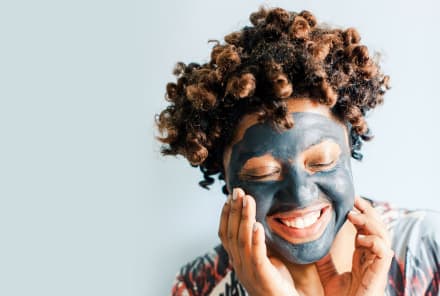Advertisement
Learn Together: How To Start A Book Club Celebrating Black Voices


These last few weeks have shown us how much work white and non-Black POCs have to do to combat racism in our communities and in ourselves. Why not do some of it together? Starting a book club focused on learning anti-racism and building empathy and understanding for Black culture is one way we can commit to continuing the conversation and taking meaningful action. Here's a loose outline for how to start yours.
Step 1: Get organized.
Extend the invitation.
Start by asking friends if they'd like to join a book club focused on race and racism, or if they have friends who might. Make expectations clear from the get-go (i.e., we will be reading one book and holding one hourlong discussion a month) so everyone knows what they're committing to.
Keep in mind that the people you end up with will likely have some similar ideologies and viewpoints, as friend groups tend to do. That's important to acknowledge: Celebrate the people who've joined in, but be aware of the perspectives that aren't there too.
Set up a group thread.
Find a virtual platform that everyone in your group can join: Maybe it's a text group, Facebook, email chain, etc. This is also the time to decide how your group will meet. If you live in an area where shelter-in-place rules are still in effect, consider getting together via Zoom, Google Hangouts, or another video communication platform everyone has access to and knows how to use.
Decide on your first book (or other form of media).
Next up: Choosing your first read. In my experience, the easiest way to do this is to designate one person who will choose two to three options that the group can vote on in your thread. (The person choosing these can change every time.)
As for what should be nominated, that's up to you! There are plenty of anti-racism resources already out there, and mbg has rounded up a few educators in the space here. Consider starting with one of them and working out from that medium as time goes on. Nonfiction is a wonderful tool for learning and unlearning—but so are novels, essays, memoirs, and collections of poetry centered in Black culture.
In her critique of the anti-racist reading list on Vulture, writer and professor Lauren Michele Jackson writes that expanding beyond the classic anti-racism texts is a way to explore more of the "holistic racial puzzle." Books by Black authors that don't exist for self-growth of the reader, but rather for the personal expression of the author, have a place on our shelves too. Here's a list of 29 of them that can help build empathy and understanding, and here are dozens of Black-owned bookstores you can order them from. (While you're browsing, you might want to also buy a new journal to write down your reactions to the book discussions; more on that below.)
The group can always veer away from the written word, too, and discuss podcasts, lectures, movies, etc., instead. Seeing White (podcast), Code Switch (podcast), 13th (movie), and Just Mercy (movie) are all available to tune into for free right now.
Plan for your first meeting.
Find a date that works for everyone to discuss the first pick. Book clubs often meet monthly, but depending on the assignment, people may need more or less time, so stay flexible.
It helps to have a leader to guide the discussion—especially in the age of virtual meetups. This person doesn't need to speak or share more than anyone else, and they certainly don't need to critique other people's reactions to the book. They are just the facilitator who keeps the conversation moving. Consider having the same person who nominated the book be the facilitator for that session, and switch off who takes on this role every meeting.
The facilitator can send out any more universal questions or prompts for the group to keep in mind as they're reading ahead of time, so everyone comes to the meeting with some thoughts to share. Of course, more specific questions will come up once you actually do the reading, but these can help kick-start the conversation. Here are a few that I've read and bookmarked or been asked directly over the last few days:
- "What is your earliest experience dealing with race and/or racism?" the New York Times (shared in an article written for teaching kids about racism, but this feels relevant for adults, too)
- "How do you benefit from your racial identit(ies)?" Teaching Tolerance
- "What has prevented you from engaging in anti-racism work in the past?"
- "What does it mean to be white?" Robin DiAngelo
Step 2: Meet up with the intention of having an honest discussion.
Make sure everyone knows each other.
If needed, set aside a few minutes at the start of the first meeting for everyone to introduce themselves and share why they wanted to join the group.
Set some ground rules.
This is important to do anytime people meet with the intention of getting vulnerable. They can include:
- Don't interrupt people who are speaking.
- If someone uses overtly or subtly racist language, agree that the group will call this out.
- If someone doesn't feel comfortable sharing one week, they don't have to (but should maybe consider what's holding them back).
- People can be comfortable sharing their honest thoughts and reactions, knowing the group will hold space for them.
Decide on format.
This one might take some iterating depending on the size of your group and the platform you're meeting on. If you have a smaller group (I'm thinking five people or fewer), discussing all together should be doable. If your group is on the larger side, you may want to break out into smaller groups to talk through questions before joining together for a larger discussion. Switch up these smaller groups each meeting so everyone gets a chance to talk with one another.
Talk through what you read.
The facilitator should come prepped with questions to ask the group that relate to what they have just read or listened to. Look online to see if your book already has an associated study guide or discussion questions provided by the author. If not, you'll need to compile a list yourself: Keep those initial questions that you sent out before the reading in your back pocket. They can be weaved in if there is a lag in conversation.
Discussing racism can get uncomfortable, especially for white people who were raised to believe that racism wasn't an issue anymore or wasn't something to be discussed. In those uneasy moments, remember these words by anti-racism educator Monique Melton: "Instead of focusing on how this work makes you feel, focus on why this work must be done, daily." Remind yourself that this discomfort is nothing compared to the pain that Black people have long lived with and keep going.
Leave a few minutes at the end for journaling.
Leave some time at the end of the meeting for anyone to share final thoughts or questions on the reading or the discussion it incited. Then, wrap up with five to 10 minutes for everyone to free write on anything that came up for them in the meeting. Where did you feel resistance and not want to share? Did anything the group said change the way you think about race or racism? These are questions to explore in your journal.
This idea is inspired by an Instagram post from actor and activist Brandon Kyle Goodman, which asserts that white people should treat the work of being an ally like going back to school to relearn matters of race. Writing in the same journal every week can help you look back over time and track how your thoughts and behaviors have shifted over the course of this adult education.
Step 3: Hold each other accountable and translate your conversations into action.
This is the most important step. The work doesn't end once you read the book. That's where it starts. Treat your group thread as a space where everyone can share how they are translating the words they've consumed into action, and hold each other accountable for doing the same.
Watch Next
Enjoy some of our favorite clips from classes
Enjoy some of our favorite clips from classes
What Is Meditation?
Mindfulness/Spirituality | Light Watkins
Box Breathing
Mindfulness/Spirituality | Gwen Dittmar
What Breathwork Can Address
Mindfulness/Spirituality | Gwen Dittmar
The 8 Limbs of Yoga - What is Asana?
Yoga | Caley Alyssa
Two Standing Postures to Open Up Tight Hips
Yoga | Caley Alyssa
How Plants Can Optimize Athletic Performance
Nutrition | Rich Roll
What to Eat Before a Workout
Nutrition | Rich Roll
How Ayurveda Helps Us Navigate Modern Life
Nutrition | Sahara Rose
Messages About Love & Relationships
Love & Relationships | Esther Perel
Love Languages
Love & Relationships | Esther Perel

















